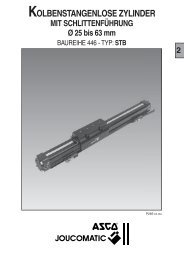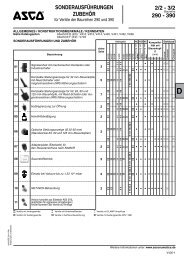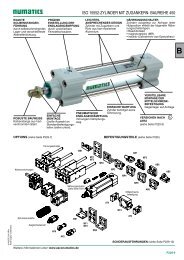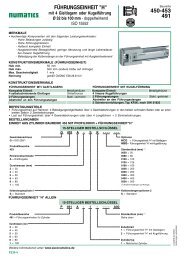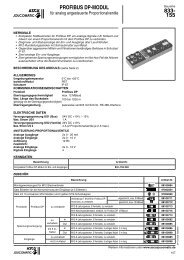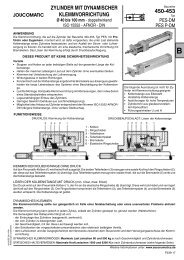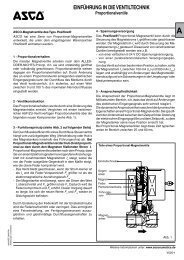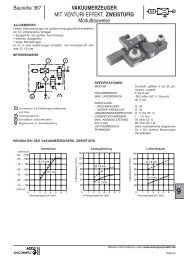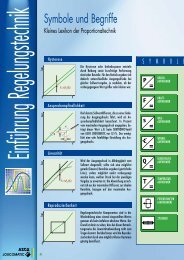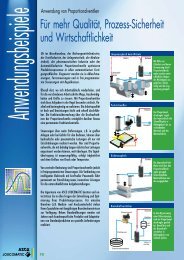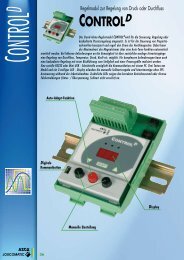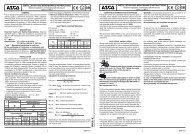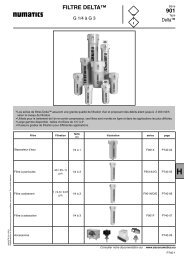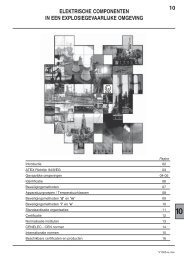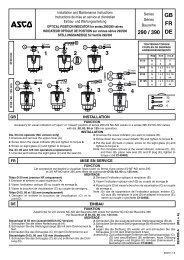ENGINEERING INFORMATION - ASCO Numatics
ENGINEERING INFORMATION - ASCO Numatics
ENGINEERING INFORMATION - ASCO Numatics
Create successful ePaper yourself
Turn your PDF publications into a flip-book with our unique Google optimized e-Paper software.
00011GB-2006/R01<br />
Availability, design and specifi cations are subject to change without notice. All rights reserved.<br />
Importance of properly sizing valves<br />
It is important to properly size a valve. There<br />
are undesirable effects in both undersizing<br />
and oversizing.<br />
Undersizing may result in:<br />
1) the inability to meet desired fl ow requirements<br />
2) the fl ashing of liquids to vapours on the<br />
outlet side of the valve<br />
3) a fall in the outlet pressure<br />
4) substantial pressure losses in the piping<br />
system<br />
Oversizing may result in:<br />
1) unnecessary cost of oversized equipment<br />
2) variable fl ow through the valve or erratic<br />
control of the fl ow<br />
3) shorter life of some valve designs through<br />
oscillating of internal parts to maintain<br />
required internal pressure differentials,<br />
caused by lack of fl ow<br />
4) erratic operation of some designs such<br />
as failure to shift position due to lack of<br />
required fl ow in 3- and 4-way valves<br />
5) erosion or wire drawing of seats in some<br />
designs because they operate in the<br />
nearly closed position<br />
Defi nition of Kv<br />
The fl ow coeffi cient Kv in cubic metres per<br />
hour or litres per minute is a special volumetric<br />
fl ow rate (capacity) through a valve<br />
at a specifi ed travel and at the following<br />
conditions:<br />
- the static pressure loss (�p Kv ) across the<br />
valve is 10 5 Pa (1 bar)<br />
- the fl uid is water within a temperature<br />
range of 278 K to 313 K (5°C to 40°C)<br />
- the unit of the volumetric fl ow rate is cubic<br />
metre per hour or litres per minute<br />
The Kv value can be obtained from test<br />
results with the help of the following equation:<br />
Kv Q p Δ Kv . ρ<br />
=<br />
Δp<br />
. ρ<br />
w<br />
where:<br />
Q is the measured volumetric fl ow rate<br />
in cubic metres per hour or litres per<br />
minute<br />
�p Kv is the static pressure loss of 10 5 Pa<br />
(see above)<br />
�p is the measured static pressure loss<br />
across the valve in pascals<br />
<strong>ENGINEERING</strong> <strong>INFORMATION</strong><br />
Flow data,<br />
fl ow factor and orifi ce size<br />
� is the density of the fl uid in kilograms<br />
per cubic metre<br />
�w is the density of water (see above) in<br />
kilograms per cubic metre (according<br />
to IEC 534)<br />
Conditions to be known<br />
In general, we must know as many of the<br />
conditions surrounding the application as<br />
possible.<br />
Flow required in cubic metres per hour<br />
(m 3 /h) for liquids, normal cubic metres per<br />
hour (nm 3 /h) for gases, or kilograms per<br />
hour (kg/h) for steam. These fi gures can be<br />
obtained by simply asking the customer's<br />
requirements or referring to the nameplates<br />
on pumping equipment, boiler room charts<br />
or calculations.<br />
Inlet Pressure (p 1 ) - This is usually obtained<br />
from the source of the supply or by placing<br />
a pressure gauge near the valve inlet.<br />
Outlet Pressure (p 2 ) - This can be obtained<br />
by gauge observations, but usually is tied<br />
in with specifi cations regarding allowable<br />
system pressure drop. If we know the inlet<br />
pressure and the pressure drop, then the<br />
outlet pressure is easy to determine.<br />
Pressure Drop ��p) - In large or complicated<br />
systems, it is desirable to keep the pressure<br />
drop across a valve to a minimum, and often<br />
the customer will have defi nite specifi cations<br />
concerning the factor. Of course, if the valve<br />
is discharging to atmosphere, the pressure<br />
drop is equal to the inlet pressure when dealing<br />
with liquids. However, when sizing valves<br />
for use with gases and steam, although the<br />
valve may be discharging to atmosphere,<br />
only 50 percent of the inlet pressure can<br />
be used for the pressure drop used in the<br />
formulas (commonly called critical pressure<br />
drop). In all other cases, the pressure drop<br />
is the difference between inlet and outlet<br />
pressures.<br />
Note: It is often diffi cult to understand the<br />
meaning of the term "minimum operating<br />
pressure differential" (see page V045).<br />
Certain pilot operated valves function by<br />
differential pressures created internally<br />
by "pilot" and "bleed" arrangements. This<br />
differential is measured as the difference<br />
between inlet and outlet conditions on all<br />
valve construction. If pressure conditions<br />
are not known, but only fl ow information,<br />
we can use the graphs or formulas to solve<br />
the resulting pressure drop.<br />
If the drop is less than assigned minimum<br />
differential, the valve is oversized. In these<br />
situations, a valve with a lower minimum<br />
operating pressure differential should<br />
be employed or, alternatively, a smaller<br />
sized valve with a more closely defi ned<br />
Kv factor.<br />
The formulas necessary to determine the Kv<br />
are quite complicated and for that reason a<br />
series of fl ow graphs was developed which<br />
reduce that problem to one of a simple<br />
multiplication or division.<br />
All fl ow calculations for a fl uid have been<br />
simplifi ed to a basic formula:<br />
Flow required: Q<br />
Kv = ---------------------<br />
Graph factors: Fgm , Fsg , Fgl The graph factors F gm , F sg , F gl can be easily<br />
picked out by aligning known pressure conditions<br />
on the graphs I to X on the following<br />
pages (for calculations see next page).<br />
The tables below can be used to estimate a<br />
Kv if the orifi ce size is known, or to relate the<br />
approximate orifi ce size if the Kv is known.<br />
The chart is based on the <strong>ASCO</strong> <strong>Numatics</strong><br />
design of in-line globe type valves. The fl ow<br />
charts must be used for precise sizing and<br />
converting Kv factors to actual fl ow terms,<br />
and the catalogue page must be consulted<br />
for the actual Kv of a particular valve.<br />
Approx.<br />
orifi ce<br />
size<br />
approx. Kv<br />
Approx.<br />
orifi ce<br />
size<br />
approx. Kv<br />
(mm) (m³/h) (l/min) (mm) (m³/h) (l/min)<br />
0,8 0,02 0,33 13 3 50,0<br />
1,2<br />
1,6<br />
2,4<br />
3,2<br />
3,6<br />
4,8<br />
6,4<br />
8<br />
9<br />
0,05<br />
0,08<br />
0,17<br />
0,26<br />
0,31<br />
0,45<br />
0,60<br />
1,5<br />
1,7<br />
0,83<br />
1,33<br />
2,83<br />
4,33<br />
5,17<br />
7,50<br />
10,0<br />
25,0<br />
28,3<br />
16 4 66,7<br />
18 4,5 75,0<br />
19 6,5 108<br />
25 11 183<br />
32 15 250<br />
38 22 366<br />
51 41 683<br />
64 51 850<br />
76 86 1433<br />
80 99 1650<br />
100 150 2500<br />
125 264 4400<br />
150 383 6375<br />
All leafl ets are available on: www.asconumatics.eu<br />
V050-1<br />
A
SAMPLE PROBLEMS<br />
LIQUIDS (Tables I and III)<br />
To fi nd Kv: What Kv is required to pass 22 litres<br />
of oil per minute with a specifi c gravity<br />
of 0,9 and a pressure drop of 1,5 bar?<br />
The viscosity is less than 9° Engler.<br />
Solution: The formula is:<br />
3 Q<br />
Kv (m /h) =<br />
Q<br />
Kv (l/min) =<br />
3<br />
(m /h)<br />
Fgm . Fsg<br />
3<br />
(m /h)<br />
Fgl . Fsg<br />
To fi nd Fg, use the Liquid Flow Graph.<br />
The Fgm factor is that corresponding to a<br />
pressure drop of 1,5 bar and equals 1,25.<br />
The Fgl factor is 0,075.<br />
The Fsg factor can be obtained from the<br />
Fsg chart and is that corresponding to 0,09<br />
specifi c gravity and equals 1,05.<br />
Therefore:<br />
−3<br />
Kv =<br />
60. 22. 10<br />
= 1<br />
125105 , . ,<br />
3<br />
m /h<br />
−3<br />
Kv =<br />
60. 22. 10<br />
= 16, 7 l/min<br />
0, 075. 1, 05<br />
Flow data, fl ow factor and orifi ce size - <strong>ENGINEERING</strong> <strong>INFORMATION</strong><br />
AIR AND GASES (Tables I and IV - VII)<br />
To fi nd Kv: A valve is required to pass<br />
14 nm 3 /h at an inlet pressure of 4 bar and<br />
a pressure drop (�p) of 0,5 bar.<br />
Find the Kv if the fl uid is carbon dioxide.<br />
Solution: Refer to the 1-10 bar graph.<br />
The formula used is:<br />
3<br />
3 Q (Nm /h)<br />
Kv (Nm /h) =<br />
.<br />
Q<br />
Kv (Nl/min) =<br />
F F<br />
gm sg<br />
3<br />
(Nm /h)<br />
Fgl . Fsg<br />
Locate Fgm at the intersection of 4 bar inlet<br />
pressure and 0,5 bar pressure drop �p (along<br />
curve). Read down to Fgm = 43,5.<br />
Fgl factor is 2,61.<br />
Locate Fsg corresponding to specifi c gravity<br />
of carbon dioxide (= 1,5) on Fsg Chart.<br />
Fsg = 0,81<br />
Insert values into formula:<br />
Kv Q<br />
3<br />
(Nm /h)<br />
= =<br />
14<br />
3<br />
= , Nm /h<br />
F . F 43, 5. 0, 81 04<br />
gm sg<br />
Kv Q<br />
3<br />
(Nm /h)<br />
= =<br />
14<br />
= , Nl/min<br />
F . F 261081 , . ,<br />
662<br />
gl sg<br />
Formula for liquid Formula for gases (with temperature correction) (1)<br />
(S.G.) (kg/m 3 ) : specifi c gravity related to water for liquids<br />
(S.G.)N (kg/m 3 ) : specifi c gravity related to air for gases<br />
T1 (°C) : fl uid temperature at the valve inlet<br />
T2 (°C) : fl uid temperature downstream of the valve<br />
Q (m 3 /h) : fl ow<br />
QN (Nm 3 /h) : volumetric fl ow across the valve<br />
Kv (m 3 /h) : fl ow coeffi cient<br />
p 1 (bar) : pressure at the valve inlet<br />
p 2 (bar) : pressure downstream of the valve<br />
Δp (bar) : pressure drop<br />
All leafl ets are available on: www.asconumatics.eu<br />
V050-2<br />
STEAM (Tables VIII - X)<br />
To fi nd Kv: A valve is required to pass<br />
25 kg/h of saturated steam at an inlet pressure<br />
of 1 bar and a �p of 0,2 bar.<br />
What is the Kv?<br />
Solution: Refer to the appropriate Steam<br />
Graph.<br />
Use the formula:<br />
3 Q (kg/h)<br />
Kv (m /h) =<br />
Fgm Q (kg/h)<br />
Kv (l/min) =<br />
Fgl Locate Fg on graph corresponding to 1 bar<br />
inlet pressure and a �p of 0,2 bar (along<br />
curve).<br />
Fgm = 13,8 and the Fgl = 0,83<br />
Insert values into formula:<br />
Kv Q (kg/h)<br />
= =<br />
25<br />
= 18 ,<br />
Fgm 13, 8<br />
3<br />
m/h<br />
Kv Q (kg/h)<br />
= =<br />
25<br />
= 30 l/min<br />
Fgl 083 ,<br />
(1) To calculate the volumetric fl ow QN we must know:<br />
- the KV coeffi cient<br />
- the specifi c gravity (S.G.)N of the fl uid<br />
- the pressure loss Δp across the valve<br />
- the fl uid pressure p 2 downstream of the valve<br />
- the fl uid temperature T1 at the valve inlet<br />
00011GB-2006/R01<br />
Availability, design and specifi cations are subject to change without notice. All rights reserved.
00011GB-2006/R01<br />
Availability, design and specifi cations are subject to change without notice. All rights reserved.<br />
Table I : Calculation factor Fsg Table II : Calculation factor Ft for temperature correction<br />
Factor Fsg<br />
OTHER GRAVITIES<br />
Factor Fgl (l/min)<br />
0,54<br />
0,48<br />
0,42<br />
0,36<br />
0,30<br />
0,24<br />
0,18<br />
0,12<br />
0,06<br />
0,03<br />
0<br />
Factor Fgm (m 3 /h)<br />
Specifi c gravity (S.G.)<br />
specifi c gravity (for 1 bar absolute and 15°C)<br />
Table III : Flow calculation Fgm and Fgl for liquids<br />
Flow data, fl ow factor and orifi ce size - <strong>ENGINEERING</strong> <strong>INFORMATION</strong><br />
Factor Ft<br />
OTHER TEMPERATURES<br />
FLUID TEMPERATURE t 2 (°C)<br />
The correction for temperature in the<br />
range of -7°C to 65°C is very small<br />
and, therefore, can be ignored in<br />
ordinary applications<br />
Pressure drop �p (bar)<br />
All leafl ets are available on: www.asconumatics.eu<br />
V050-3<br />
A
Table IV : Flow calculation Fgm and Fgl for air/gas<br />
Inlet pressure 0,01 to 0,1 bar gauge)<br />
Limiting fl ow curve - Do not read<br />
beyond this curve<br />
Factor Fgm (m 3 /h)<br />
0,17 0,18 0,21 0,24 0,27 0,30 0,36 0,42 0,48 0,54<br />
Factor Fgl (l/min)<br />
Table V : Flow calculation Fgm and Fgl for air/gas<br />
Inlet pressure of 0,1 to 1 bar (gauge)<br />
Flow data, fl ow factor and orifi ce size - <strong>ENGINEERING</strong> <strong>INFORMATION</strong><br />
Pressure drop �p (bar)<br />
Limiting fl ow curve - Do not read<br />
beyond this curve<br />
Pressure drop �p (bar)<br />
Factor Fgm (m 3 /h)<br />
0,24 0,30 0,36 0,42 0,48 0,6 0,72 0,84 0,96 1,08 1,2 1,32 1,44 1,56 1,68 1,8 1,92 2,04<br />
0,54 0,66 0,78 0,9 1,02 1,14 1,26 1,38 1,5 1,62 1,74 1,86 1,98 2,1<br />
Factor Fgl (l/min)<br />
All leafl ets are available on: www.asconumatics.eu<br />
V050-4<br />
00011GB-2006/R01<br />
Availability, design and specifi cations are subject to change without notice. All rights reserved.
00011GB-2006/R01<br />
Availability, design and specifi cations are subject to change without notice. All rights reserved.<br />
Table VI : Flow calculation Fgm and Fgl for air/gas<br />
Inlet pressure of 1 to 10 bar (gauge)<br />
Inlet pressure 10 to 100 bar (gauge)<br />
0,6<br />
1,2<br />
1,8<br />
Table VII : Flow calculation Fgm and Fgl for air/gas<br />
0<br />
6<br />
2,4<br />
12<br />
3,0<br />
Flow data, fl ow factor and orifi ce size - <strong>ENGINEERING</strong> <strong>INFORMATION</strong><br />
18<br />
Limiting fl ow curve - Dot not read<br />
beyond this curve<br />
Pressure drop �p (bar)<br />
3,6 4,2 4,8 5,4 6 6,6 7,2 7,8 8,4 9<br />
Factor Fgm (m<br />
9,6 1,02 1,08<br />
Factor Fgl (l/min)<br />
3 /h)<br />
24<br />
30<br />
36<br />
42<br />
Limiting fl ow curve - Do not read<br />
beyond this curve<br />
Pressure drop �p (bar)<br />
Factor Fgm (m<br />
48 54 60 66 72 78 84 90 96 102<br />
3 /h)<br />
Factor Fgl (l/min)<br />
All leafl ets are available on: www.asconumatics.eu<br />
V050-5<br />
A
Table VIII : Flow calculation Fgm and Fgl for steam<br />
Inlet pressure of 0,1 to 1 bar (gauge)<br />
0,18 0,3<br />
0,24<br />
0,42 0,54 0,66 0,78 0,9<br />
0,36 0,48 0,6 0,72 0,84 0,96<br />
1,02 1,08 1,14 1,2 1,26 1,32 1,38 1,44<br />
Factor Fgm (m<br />
1,5 1,56 1,62 1,68<br />
3 /h)<br />
Factor Fgl (l/min)<br />
Table IX : Flow calculation Fgm and Fgl for steam<br />
Inlet pressure 1 to 10 bar (gauge)<br />
0<br />
Table X : Flow calculation Fgm and Fgl for steam<br />
Inlet pressure of 10 to 100 bar (gauge)<br />
0<br />
All leafl ets are available on: www.asconumatics.eu<br />
V050-6<br />
6<br />
0,6<br />
1,2<br />
12<br />
Flow data, fl ow factor and orifi ce size - <strong>ENGINEERING</strong> <strong>INFORMATION</strong><br />
1,8<br />
18<br />
2,4<br />
3,0<br />
24<br />
Limiting fl ow curve - Do not read<br />
beyond this curve<br />
3,6<br />
30<br />
4,2<br />
36<br />
4,8<br />
42<br />
Limiting fl ow curve - Do not read<br />
beyond this curve<br />
5,4<br />
48<br />
6,0<br />
54<br />
6,6<br />
60<br />
Pressure drop �p (bar)<br />
Pressure drop �p (bar)<br />
7,2<br />
Limiting fl ow curve - Do not read<br />
beyond this curve<br />
66<br />
Factor Fgm (m<br />
7,8 8,4 9,6<br />
3 /h)<br />
Factor Fgl (l/min)<br />
Pressure drop �p (bar)<br />
Factor Fgm (m<br />
72 78 84<br />
3 /h)<br />
Factor Fgl (l/min)<br />
00011GB-2006/R01<br />
Availability, design and specifi cations are subject to change without notice. All rights reserved.
00011GB-2010/R01<br />
Availability, design and specifi cations are subject to change without notice. All rights reserved.<br />
ADDITIONAL FLOW FORMULAS AND<br />
PHYSICAL DATA<br />
Flow calculation<br />
General: Pressure drop values for which no<br />
curves are shown, may be determined by<br />
interpolation in the graphs. However, more<br />
accurate results can be obtained for the<br />
calculation of the required values by using<br />
the following equations (on which the fl ow<br />
graphs are based):<br />
p = absolute inlet pressure (bar) =<br />
1<br />
gauge pressure plus atmospheric<br />
pressure of 1,013 bar<br />
p = absolute outlet pressure (bar) =<br />
2<br />
gauge pressure plus atmospheric<br />
pressure of 1,013 bar<br />
�p = p - p = pressure drop across the<br />
1 2<br />
valve (bar)<br />
t = 0°C<br />
Note: In most systems it is desirable to keep<br />
the pressure drop to a minimum. If necessary<br />
- in case of liquids - the pressure drop<br />
may equal the total inlet (gauge) pressure.<br />
This also applies to air, gases and steam<br />
up to 1,013 bar inlet (gauge) pressure but<br />
for these fl uids never use a �p greater than<br />
50% of the absolute inlet pressure because<br />
excessive pressure drops will cause an irregular<br />
fl ow. If�p is not specifi ed and this<br />
information is needed to size the valve, a<br />
rule of thumb is to take 10% of the inlet<br />
pressure as pressure drop.<br />
Liquids<br />
3<br />
Fgm = Δ p (m /h)<br />
and<br />
F = 006 p , Δ (l/min)<br />
gl<br />
Example: For �p = 1,7 bar, Fgm = 1,3 (m 3 /h)<br />
and Fgl = 0,08 (l/min) will be found.<br />
Note: If the fl uid viscosity is higher than 300<br />
SSU (approx. 9°E), the determined Kv-value<br />
must be adjusted. Contact us.<br />
Flow data, fl ow factor and orifi ce size - <strong>ENGINEERING</strong> <strong>INFORMATION</strong><br />
Defi nition of Kv (or Cv) coeffi cient<br />
Valve fl ow coeffi cient Kv (or Cv) is the fl ow of<br />
water (specifi c gravity = 1), expressed in volume<br />
unit "A" per time unit "B", that will pass<br />
Air and gases<br />
Fgm = p p − p<br />
18 9 2 , Δ ( 1 Δ ) (m³/h)<br />
Fgl = p p − p<br />
113 2 , Δ ( 1 Δ ) (l/min)<br />
Example: Δp = 0,4 bar;<br />
p = 3 bar gauge or<br />
1<br />
4,013 bar absolute.<br />
Calculation:<br />
3<br />
Fgm = 18, 9 0, 4( 8, 026 − 0, 4) = 33 m/h<br />
Fgl = 1, 13 0, 4( 8, 026 − 0, 4) = 1, 97 l/min<br />
Note: The gas equations only apply accurately<br />
to a fl uid temperature of 20°C (for the<br />
purpose of this catalogue, the standard cubic<br />
metre nm 3 has been defi ned at 20°C and<br />
1,013 bar absolute or 760 mm mercury).<br />
At a different temperature (= t 2 °C) the<br />
determined Kv 1 value must be adjusted by<br />
the following correction factor.<br />
F<br />
t =<br />
293<br />
+ t<br />
273 2<br />
Specifi c gravity of various liquids at 20°C<br />
(related to water at 4°C)<br />
Alcohol, Ethyl 0,79<br />
Bezene 0,88<br />
Carbon tetrachloride 1,589<br />
Castor Oil 0,95<br />
Fuel Oil no. 1 0,83<br />
Fuel Oil no. 2 0,84<br />
Fuel Oil no. 3 0,89<br />
Fuel Oil no. 4 0,91<br />
Fuel Oil no. 5 0,95<br />
Fuel Oil no. 6 0,99<br />
Gasoline (petrol) 0,75 to 0,78<br />
Glycerine 1,26<br />
Linseed Oil 0,94<br />
Olive Oil 0,98<br />
Turpentine 0,862<br />
Water 1,000<br />
The actual fl ow factor is: Kv<br />
2<br />
Kv<br />
=<br />
F t<br />
1<br />
through a valve at a pressure drop equal to<br />
pressure unit "C" (see table below).<br />
Kv and Cv conversion table<br />
units<br />
volume "A"/ time "B" pressure "C"<br />
symbol conversion formulas<br />
l / min bar Kv 1 Kv = 0,06 Kvh = 0,05 Cve = 0,07 Cv<br />
m3 / h bar Kvh 1 Kvh = 16,7 Kv = 0,97 Cve = 1,17 Cv<br />
gallon GB (Imp. gallon) / min psi Cve 1 Cve = 17,1 Kv = 1,03 Kvh = 1,2 Cv<br />
gallon US / min psi Cv 1 Cv = 14,3 Kv = 0,85 Kvh = 0,83 Cve<br />
Steam and vapours (e.g. refrigerants)<br />
For steam:<br />
Fgm = p P − P<br />
15 83 2 , Δ ( 1 Δ ) (m³/h)<br />
Fgl = p P − P<br />
095 2 , Δ ( 1 Δ ) (l/min)<br />
Example: Δp = 7 bar,<br />
p 1 = 40 bar or<br />
41,013 bar abs.<br />
Calculation:<br />
Fgm = 15,83 7( 82, 026 − 7)<br />
= 363 m 3<br />
/h<br />
Fgl = 0, 95 7( 82, 026 − 7)<br />
= 21,8 l/ min<br />
Note 1: The steam formulas apply to<br />
saturated steam. For superheated steam<br />
a correction factor is required.<br />
Consult your <strong>ASCO</strong> <strong>Numatics</strong> supplier.<br />
Note 2: For vapours, e.g. chlorofl uorocarbons<br />
(CFCs), various other factors have to<br />
be considered.<br />
Specifi c gravity of various gases (at 20°C<br />
and atm. pressure and related to air)<br />
Acetylene 0,91<br />
Air 1,000<br />
Ammonia 0,596<br />
Butane 2,067<br />
Carbon dioxide 1,53<br />
Chloride 2,486<br />
Ethane 1,05<br />
Ethyl chloride 2,26<br />
Helium 0,138<br />
Methane 0,554<br />
Methyl chloride 1,785<br />
Nitrogen 0,971<br />
Oxygen 1,105<br />
Propane 1,56<br />
Sulphur dioxide 2,264<br />
All leafl ets are available on: www.asconumatics.eu<br />
V050-7<br />
A
Flow data, fl ow factor and orifi ce size - <strong>ENGINEERING</strong> <strong>INFORMATION</strong><br />
FLOW COEFFICIENTS<br />
. C and b (following standard ISO 6358) :<br />
Coeffi cients C (sonic conductance) and b (critical pressure ratio) following standard ISO 6358 allow fl ow calculation under sonic<br />
conditions (See solenoid pilot valves 195/LISC - section I).<br />
C =<br />
C =<br />
q* m<br />
ρ p ο 1<br />
q* v<br />
p1 q*: mass fl ow rate q* (kg/s) or volume q* (m m v 3 /s) through a component at sonic fl ow<br />
p : inlet pressure (bar)<br />
1<br />
ρ ο = 1,3 kg/m 3 : density under standard conditions (p 0 = 1 bar, T 0 = 293,15 K and 65% relative humidity)<br />
b : pressure ratio below which the fl ow is sonic:<br />
q m<br />
q* m<br />
b =<br />
P2 P1 depending on P 1 , T 1<br />
and C<br />
P : outlet pressure (bar)<br />
2<br />
P : inlet pressure (bar)<br />
1<br />
0 b 1<br />
Sonic fl ow Subsonic fl ow<br />
CALCULATION OF FLOW (for air and gas)<br />
. Defi ning fl ow at 6 bar :<br />
The corresponding leafl ets give for each product its mean fl ow in litres per minute at 6 bar at a standard reference atmosphere<br />
(ANR) conforming to ISO 8778 (with Δ P = 1 bar)<br />
. Calculation of fl ow :<br />
Δ P < P inlet /2<br />
Q = 28,16 x Kv x ΔP x P in<br />
including correction for temperature and density<br />
Q = 475 x Kv x (ΔP x P in )<br />
(T a x d)<br />
Q = Flow in l/min<br />
ΔP = Differential pressure, in bar<br />
P 1 and T 1 are constant<br />
Ellipse quarter, depending on<br />
P 1 , T 1 and C and b coeffi cients<br />
P out / P in<br />
All leafl ets are available on: www.asconumatics.eu<br />
V050-8<br />
T1, temperature (°K) measured when the fl ow is sonic<br />
Δ P ≥ P inlet /2<br />
(Maximum allowable fl ow)<br />
Q = 14 x Kv x P out<br />
P in = Absolute inlet pressure, in bar<br />
P out = Absolute outlet pressure, in bar<br />
including correction for temperature and density<br />
Q = 238,33 x Kv x P x 1<br />
out<br />
(T x d) a<br />
T a = Absolute temperature, in Celsius degrees<br />
d = Density compared with air<br />
00011GB-2011/R01<br />
Availability, design and specifi cations are subject to change without notice. All rights reserved.



